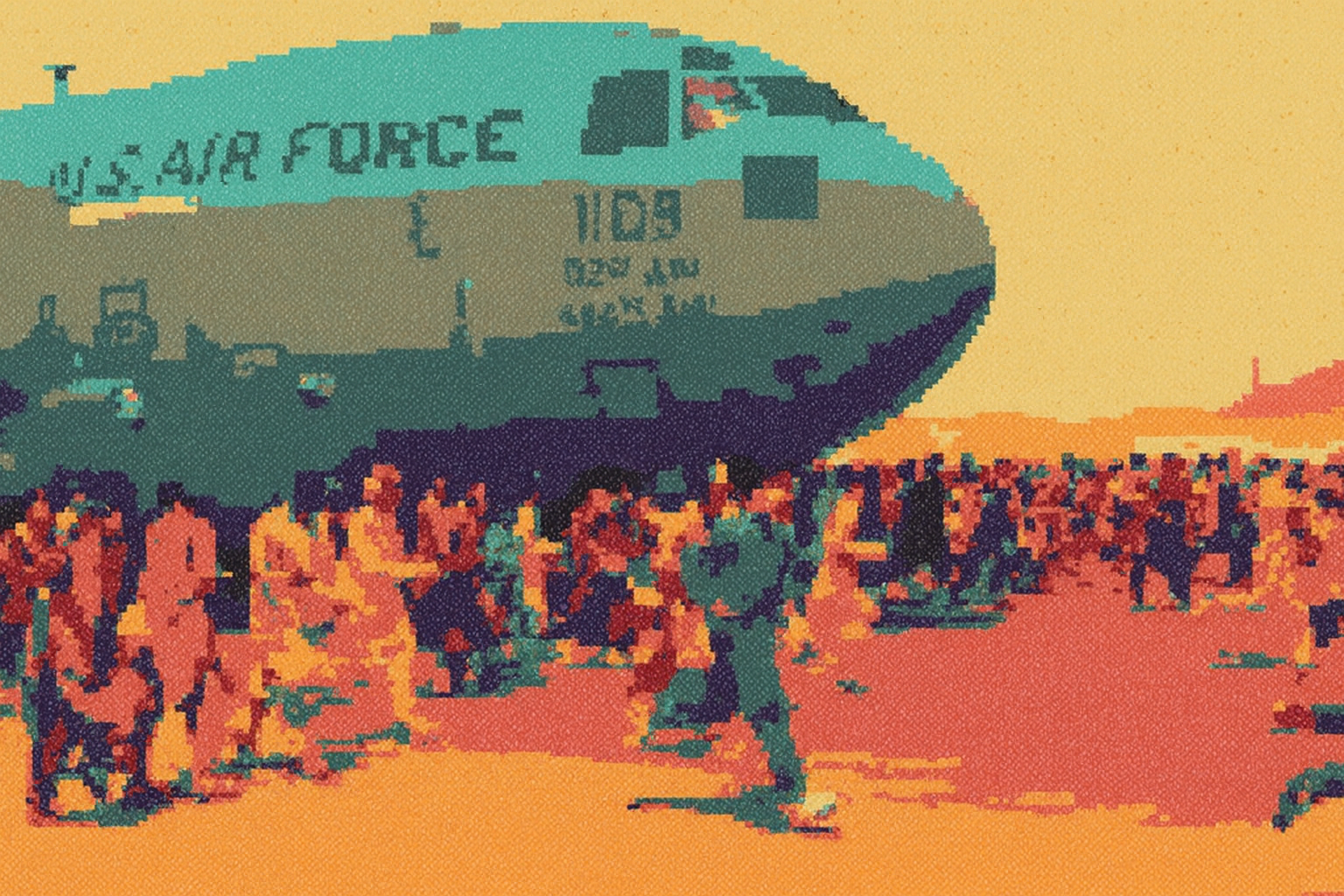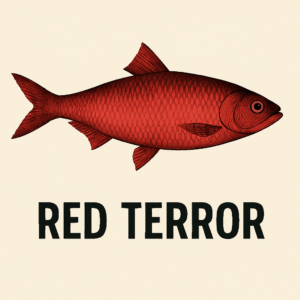“How does an empire die? Often, it seems, there is a growing sense of decay, and then something happens, a single event that provides the tipping point.”
I was in my mid-twenties when the so-called War on Terror began, at the beginning of my political education, and in my mid-forties when the “forever war” ended in Kabul with scenes that felt like history collapsing in real time: Afghans clinging to planes as they took off, helicopters circling the embassy, an empire departing in disgrace. Those two decades framed the horizon of my adulthood. I marched against the Iraq War, I read about torture at Bagram and Abu Ghraib, and I watched as the language of freedom was twisted into the justification for occupation and drone assassinations. For my generation, the War on Terror was not a temporary emergency but the air we breathed. A war without end that reshaped law, politics, and the very meaning of security. Its ending in 2021, as in Saigon before it, was less a conclusion than an exposure: proof that empires always overreach, and what they leave behind is not liberation but ruin.
Jon Lee Anderson has been writing about Afghanistan for more than thirty years, long enough to know the country is less a graveyard of empires than a theatre in which imperial illusions come to die. His new book, To Lose a War: The Fall and Rise of the Taliban, reconceives his earlier collection The Lion’s Grave (2002), updating it with dispatches through the years of occupation and into the aftermath of America’s collapse in 2021. The result is not a seamless monograph but a cumulative ledger of defeat: a war that began (for the US) with the shock of 9/11, paraded as liberation, and ended two decades later in rout.
Anderson has the advantage of having been there at the very beginning, in the Panjshir Valley with Ahmad Shah Massoud’s men, in Dasht-i-Qala with warlords, in Kabul when music returned to the streets. His method is not academic history but narrative immersion: details of gardens, tea, and pheasants mixed with accounts of airstrikes and assassinations. The reader is carried from intimate encounters with figures like Mamur Hassan or Hamid Karzai to wide-angle reflections on American imperial decline. The chapters were originally published in The New Yorker, and the lineage shows. Each essay has its own rhythm and integrity, polished in the magazine’s house style, and brought together here they retain that cadence. What comes across is the texture of serial reportage: episodic, elliptical, never quite resolved, yet gaining force through accumulation. That rhythm mirrors the war itself.

The Assassination and the Collapse
The first chapter centres on Massoud, the “Lion of Panjshir,” assassinated on 9 September 2001 by two al-Qaeda operatives posing as journalists. Anderson is right to stress the timing: remove the Northern Alliance’s only charismatic and militarily competent leader two days before 9/11, and the Americans would be left scrambling for local partners. The death of Massoud exposed the fragility of Afghan politics, where legitimacy was embodied in individual leaders rather than institutions. For the Americans, it meant leaning on warlords like Dostum or Fahim, men who could provide troops and tactical victories but no coherent national authority. The assassination was not only a tactical masterstroke by al-Qaeda but a foretaste of how Afghan politics would continue to function: assassinations as acts of strategy.
The subsequent collapse of the Taliban regime in late 2001 is told here through stories of surrender and defection. Kandahar, Kabul, and Mazar fell with astonishing speed, not because the Taliban had been annihilated but because their commanders chose to vanish into Pakistan. Anderson catches this ambiguity: the West mistook disappearance for defeat. In reality, the Taliban were making a tactical withdrawal, one that would allow them to regroup. The lesson, had anyone cared to read it, was that Afghanistan’s wars are rarely won in pitched battles. They are wars of patience, attrition, and survival.
“He was excited. “What do you think?” he said. “What should I tell him? Will you pay the two thousand dollars?” I reminded Qais that I was not a Green Beret or a CIA agent. Where would I keep an Al Qaeda prisoner?”
Anderson’s chapter on Tora Bora sharpens this point. The Americans subcontracted the hunt for Osama bin Laden to Afghan mujahideen whose loyalties were fungible. Bin Laden slipped away, likely aided by those very allies. It was the first major sign that America did not understand the terrain, the networks, or the long game.
Dreams in Kabul
When Anderson walks the streets of Kabul in 2002, there is a brief sense of possibility. Burqas are discarded, music shops open, the aid industry rolls in. The chapter “City of Dreams” catches that mood. Yet he also notes the hostility bubbling underneath: boys throwing stones at unveiled women, shopkeepers resenting the presence of Westerners. The illusion of a new Kabul was confined to a small urban elite and a foreign NGO bubble. For the countryside (overwhelmingly Pashtun, conservative, and battered by decades of war) little had changed. This disjuncture between Kabul and the provinces would haunt the entire occupation.
“the Taliban were visibly gone and, with them, their Al Qaeda friends. But, on subsequent days, as I moved around the devastated city, I had reason to wonder how genuine the Western-assisted Northern Alliance victory had been. One morning, a group of four women concealed in blue burkhas approached me on the street, and one asked if I knew of any work opportunities. I was accosted by a furious shopkeeper for daring to communicate across the gender divide.”
The city Anderson evokes is not simply hopeful but illusory: “a dream” built on aid money, expat restaurants, and Western press conferences. The Taliban were not defeated; they were waiting. The Americans, flush with hubris, confused urban spectacle for social transformation. Kabul’s population would swell from two million to nearly five, a city of wedding palaces, Turkish energy drinks, and heroin addicts under bridges. A façade of modernity overlaying the same fragility.
Warlords and Presidents
One of Anderson’s recurring strengths is his eye for Afghan power brokers. In Dasht-i-Qala he observes Mamur Hassan, a local commander who straddles the line between landlord and warlord, speaking warmly of democracy but presiding over men who fight “for me, not the Alliance.” In Kandahar he profiles Mullah Naquib, survivor and chameleon, suspected of harbouring ties with Mullah Omar. These portraits underline a simple truth: Afghan authority is patrimonial and local, grounded in land, kinship, and survival, not in imported institutions.
The Americans chose Hamid Karzai as their figurehead. Anderson’s portrait of Karzai is sympathetic but devastating. The president is polite, charming, cosmopolitan, but powerless. Promises made in palace meetings cannot be fulfilled without American money and approval. He is, as Anderson notes, “only ever the nominal president of his own country.” To Afghans, this dependency was obvious. Sovereignty was absent from the start. Karzai became, in effect, the Afghan Zelensky of his day, feted abroad, extremely fragile at home.
Quagmire
As the occupation dragged on, Anderson’s tone darkens. His embeds with American forces in 2010 and 2011 are the book’s pivot point. Riding in armoured vehicles through Maiwand, he realises he is cut off from the Afghan people; interactions are mediated through bulletproof glass and targeting screens. The soldiers are professional, exhausted, and increasingly aware that they are fighting a war of futility. The chapter title says it all: “Force and Futility.” By then it was impossible to travel safely outside Kabul without military escort. The Taliban had returned, the countryside was theirs, and the coalition was hunkered in fortified bases, unable to shape Afghan politics beyond firepower.
Anderson is blunt: whatever was being achieved by then was achieved by coercion, not persuasion. Counterinsurgency had failed. Development aid had built an economy of corruption and dependency. Counter-narcotics campaigns backfired, criminalising livelihoods while enriching traffickers. The insurgency, by contrast, had built patience.
“Before I left the field, Ahmad looked at me directly and said, “I know the opium is turned into drugs that destroy young people, and I am sorry, but we are twenty people and we have no help. We must grow it to survive. If we get help, we won’t grow it next year.”
By 2010, Anderson admits to his editor that he no longer wants one of his embed pieces published, so estranged does he feel from the Afghanistan he had once known. That self-doubt, rare in war reporting, is central to the book’s honesty. The piece appears in this selection.
Assassination as Politics
A series of short chapters in the second half track the killings of key Afghan figures: Ahmed Wali Karzai in Kandahar, Jan Muhammad Khan in Uruzgan, Burhanuddin Rabbani in Kabul. Each assassination narrowed the political field, removed moderates or brokers, and demonstrated the Taliban’s reach. To read Anderson’s account is to grasp that assassination was not collateral but the grammar of Afghan politics. Leaders emerge, gain patronage, and are cut down. In this, Afghanistan resembled the Cold War’s proxy zones in Latin America: politics by murder, encouraged or tolerated by external sponsors.
“Their [Talbian] comeback has taken twenty years, but it is a classic example of a successful guerrilla war of attrition, and has involved all the usual elements of guerrilla strategy: a stealth campaign of hit-and-run military attacks, selective assassinations to demoralize their adversaries, and acts of terror that both weakened the government and created an atmosphere of abject compliance from local populations.”
Mullah Omar himself becomes a ghostly figure, revealed years later to have been dead while his name still rallied Taliban fighters. Anderson shows how the myth endured beyond the man, proof that Afghan politics often operates through symbols as much as individuals.
The Americans’ War Crimes
“Two weeks ago it was the accidental burning of Korans and other sacred texts on an American military base—the news of which led to angry riots across Afghanistan and the deaths of at least thirty people, including six American soldiers.”
Anderson does not flinch from atrocity, and his catalogue is grim. The 2012 Panjwai massacre in Kandahar province is central: Staff Sergeant Robert Bales left his base at night, entered local homes, and murdered sixteen civilians, nine of them children, before setting bodies on fire. Anderson reconstructs the horror through survivors’ testimony — a father who returned to find his family slaughtered, children with burns from beds set alight. What struck Afghans most was not only the killings but the impunity: the sense that a single American could snuff out Afghan lives at will, then be spirited away for trial abroad.
This massacre is not treated in isolation but as part of a chain. There were the Qur’an burnings at Bagram in 2012, when US soldiers tossed religious texts into incinerators, sparking nationwide riots and deadly protests. There were the “trophy” photos of paratroopers grinning beside the corpses of Afghans they had mutilated, released by the Los Angeles Times the same year. There were the night raids in which families were dragged from their homes, the drone strikes that obliterated wedding parties, the torture at black sites and detention centres. Each incident became a story told and retold in Afghan villages, feeding the Taliban’s recruitment and confirming the narrative that foreigners brought only humiliation and death.
Into this landscape steps Jonathan “Jack” Idema, a former US Green Beret who set up his own private detention and torture facility in Kabul. Idema kidnapped Afghans, chained them in filthy cells, and subjected them to beatings and electric shocks until Afghan police finally intervened in 2004. His shadowy operation, carried out under the pretext of counterterrorism, was chillingly reminiscent of Abu Ghraib: improvised cells, sadistic treatment, and the tacit tolerance of an occupying power willing to look away. For Afghans, it hardly mattered whether the abuse was carried out by uniformed soldiers or freelance rogues. The humiliation was the same, and each case reinforced the perception of America as an occupying power without discipline or moral ground.
Anderson is clear: these were not aberrations, not the work of “bad apples.” They were the inevitable product of an occupying army cut off from the society it claimed to save. Soldiers moved through the country in armoured convoys, their only interactions with Afghans shaped by suspicion, language barriers, and the constant threat of attack. Violence became normalised, the population dehumanised, and when atrocity surfaced it was less a shock than the lifting of a curtain. As with Iraq’s Haditha massacre or Abu Ghraib prison, Afghanistan’s war crimes revealed the systemic rot of an imperial project built on domination rather than solidarity.
For Afghans, these crimes were not footnotes but the war itself. Each atrocity confirmed that American talk of human rights was hollow. Each corpse undercut every leaflet promising schools or clinics. In Anderson’s telling, the real counterinsurgency was waged not with aid or “hearts and minds” campaigns but through terror, whether deliberate or careless. The Taliban did not need to invent propaganda; they needed only to point to the charred beds of Panjwai.
The Return
By 2015, the Taliban were taking cities again: Kunduz fell, briefly but symbolically, demonstrating that the insurgency was not confined to the south. In 2021, the endgame came with astonishing speed. Provincial capitals collapsed one after another, the Afghan army evaporated, and Kabul fell without a fight. Anderson captures the shock but insists the inevitability was clear to anyone who had watched closely: the Taliban had never been defeated, merely displaced. They returned as soon as the Americans tired.
The final chapters place Afghanistan in a larger imperial frame. The images of desperate Afghans clinging to aircraft, then falling to their deaths, were more than tragedy: they were symbols of American decline. Anderson compares Kabul 2021 to Saigon 1975, to Suez 1956, to the Soviet retreat of 1989. The resonance is clear: empires leave Afghanistan humiliated.
“However much he [Biden] says that he does “not regret” his decision, his presidency will be held responsible for whatever happens in Afghanistan now, and the key words that will forever be associated with the long American sojourn there will include hubris, ignorance, inevitability, betrayal, and failure.”
After the Fall
When Anderson returns to Kabul in late 2021, the city has changed again. The Taliban ride US Humvees, man checkpoints, wear wraparound sunglasses. Some affect a jihadi aesthetic, others look like US special forces. Civilians and Taliban ignore one another on the streets, a coexistence marked by fear and distance. Women protest, briefly, and are beaten back. Shopkeepers pre-emptively paint over advertisements featuring women’s faces. Yet the repression is laxer than in the 1990s; smartphones and Bollywood posters coexist uneasily with Taliban rule.
Anderson interviews Taliban officials who speak of women’s rights only to deflect to Western sanctions. Their ambiguity is tactical, their intentions opaque. What remains clear is the Taliban’s conviction that their victory is total, their ideology righteous. For Afghans, it means another cycle of authoritarian rule. For the US, it means defeat. Not just tactical, not temporary, but strategic.
“To most of the Taliban, Kabul is terra incognita—a cosmopolitan enclave in an otherwise rural, and deeply traditional, country. To the city’s residents, the Taliban are interlopers, as out of place as Texas militiamen on the Upper West Side.”
The Book’s Argument
This is not an academic monograph but the accumulation of a reporter’s field notes, the kind of writing shaped by dust, checkpoints, and the sudden crack of gunfire. But across two decades of reporting, a Marxist reading is clear enough. The Americans mistook military supremacy for political control. They built a comprador elite in Kabul, dependent on foreign money, unable to command loyalty beyond the city. They ignored the material realities of Afghan life: land, kinship, opium, and the endurance of conservative religious structures. They privileged spectacle over substance: elections, constitutions, women’s NGOs, the visible signs of modernity in the capital. The Taliban, by contrast, played the long game, retreating when necessary, drawing on cross-border sanctuaries, using assassination to remove rivals, and presenting themselves (however brutally) as authentically Afghan.
The book also functions as an anatomy of imperial decline. Afghanistan was not Vietnam redux so much as a demonstration that America’s model of occupation (counterinsurgency, nation-building, drone strikes, aid dependency) had reached exhaustion. When Anderson writes that the Taliban’s victory “signalled the decline of the US, both as global policeman and as model of democracy,” he is pointing to more than Kabul. Six months later, Putin invaded Ukraine, buoyed by American humiliation. The imperial game moves elsewhere, but the pattern remains.
Anderson’s Method
What makes Anderson’s work compelling is not theory but texture. He has an eye for incongruity: burkha-clad women transformed into wraiths as they slip home; Taliban fighters who once crossed out baby soap adverts now scrolling through smartphones; pheasants breaking into song in the garden of a warlord. He resists abstraction, instead showing how history is lived. Because he stays with people and places, rather than abstractions, the failure of imperial rule comes through all the more starkly.
Conclusion
To Lose a War is not a seamless academic study, but it doesn’t need to be. Its power lies in the accumulation of experience, in the way Anderson circles back to Afghanistan over decades, showing us what the occupiers could never quite see. The Americans believed they were remaking a state; in reality they were propping up a palace in Kabul while the countryside slipped away. They believed they had defeated the Taliban; in reality the Taliban had withdrawn to wait. They believed counterinsurgency could win hearts and minds; in reality their presence created more enemies than friends.
“Gailani shook his head. “The fact is, most of the money that supposedly came to Afghanistan—probably eight and a half dollars out of every ten—went back to the US, and meanwhile the corruption here was out of control. Afghan society became corrupted, and it was that corruption which brought about this day, with the Taliban back in power.” With a smile, Gailani said, “The Americans spent two and a half trillion dollars to clear this country from the Taliban, only to give it back to them again. I will go to my grave trying to figure out this riddle.”
Reading Anderson now, after Kabul’s fall, I am reminded that the War on Terror framed my own adulthood. His book captures what those years revealed: that America’s power was always brittle, its victories illusory, its exit inevitable. To lose a war is not simply to be beaten in the field; it is to misunderstand the conflict from the start. That, Anderson makes clear, is what happened in Afghanistan.




